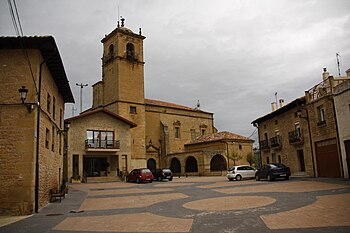|
Yécora/Iekora
Yécora (Basque: Iekora) is a town and municipality in the province of Álava, in the Basque Country, northern Spain. GeographyYecora has an area of 18.8 km ² and a population of 299 inhabitants (2008). Yecora is situated in southern Álava, within the wine region of Rioja Alavesa, on the border with Navarre, close to La Rioja. Yecora is at 694m above sea level, at the foot of the mountains of Cantabria and Codes. The adjacent municipalities are Lapoblación to the north; Oyón-Oion to the south-east; and Lanciego/Lantziego to the west. The capital of the region, Laguardia, is 15 km to the west. The provincial capital, Vitoria-Gasteiz is 50 km away. The city of Logroño, capital of La Rioja is 13 km to the south. The nearest villages are Lanciego and Lapoblación. Economy and societyYécora is a rural community, with 37% of the workforce working in agriculture and wine production. There are 4 wineries in the village, (/ / John Campinún Vallarmen, and Jalon Ibalonja Solar) that produce Rioja as well as a cooperative, St. Sixtus, which produces wines and Valsierra Campolengo. The village has a swimming pool, opened in 2006, a health centre, leisure centre and auditorium. HistoryThe village is first recorded in the 11th century cartulary of San Millán under the name Equora or Ecora. It was then known as Laguardia; in 1669 the king Charles II granted the title of town. The community later adopted the official name Yécora (or Iekora). HeritageYécora has many Renaissance buildings. The most prominent building is the church of San Juan Bautista, built in Gothic and Renaissance style. It has a 14th-century square tower, a Renaissance façade decorated with angels and two columns with Corinthian capitals. Outside the town is the shrine of Santa María de Bercijana which was restored in 1984. There is a medieval spring known as the Fuente Vieja. Festivals and traditionsSeveral processions are held during the year at the Bercijana shrine. The most important festivals are Santo Domingo in May and the harvest thanksgiving in August.
These celebrations, together with a traditional pilgrimage to San Tirso in the Sierra de Cantabria in June, are usually held annually in the town. Famous people
References
External links |
||||||||||||||||||||||||||||||||||||||||||||
Portal di Ensiklopedia Dunia


